Sydney International Open 2019
While earlier editions of the tournament had been held in Parramatta, a suburb around 20 minutes train ride to the west of Sydney's central business district, the event's new home this year was the leafy Macquarie University campus in North Ryde and it came packaged as part of the Macquarie University Chess Festival.
Alongside the main open, the traditional fixtures of an Australian tournament were in evidence: the blitz tournament, the challengers' section and the commentary by GM Ian Rogers.

The path to the playing venue | Photo: Helen Milligan/New Zealand Chess News
Added to these was an element that piqued my interest: the promotion of a new game called Chess Plus, an Australian innovation which promises to become popular with players worldwide and has already won several awards for design.
The defining feature of the game is that pieces can split and merge, changing their powers along the way. A variant of the game has been played in amateur circles in at least three countries before, but never commercialized! Chess Plus features sleek, Scandinavian-birch type pieces that slide into each other to pair up (only two pieces can be joined at a time) and a detailed printed rule set. The contrast could not be greater with the first time I got introduced to a similar game by Chinese now-GM Fang Yuxiang (in Hungary in 2014) with the laconic line: "兵 吃马 的 时候 就 可以 加 上 马 的 功 能" (When a pawn takes a knight, it gains the knight's powers)!
The first I heard of this year's festival was in January, when British-Australian IM Gary Lane told me it was being revived. (It didn't take me long to fire off an email about conditions and get a reply from Shaun Press — an old acquaintance who I wrongly assumed was the chief organiser!) In fact there was a new chief organiser, but Gary was nevertheless well-connected enough to hear about the event within days of its confirmation; at the closing ceremony it was revealed that the event had only been confirmed with four months lead time.
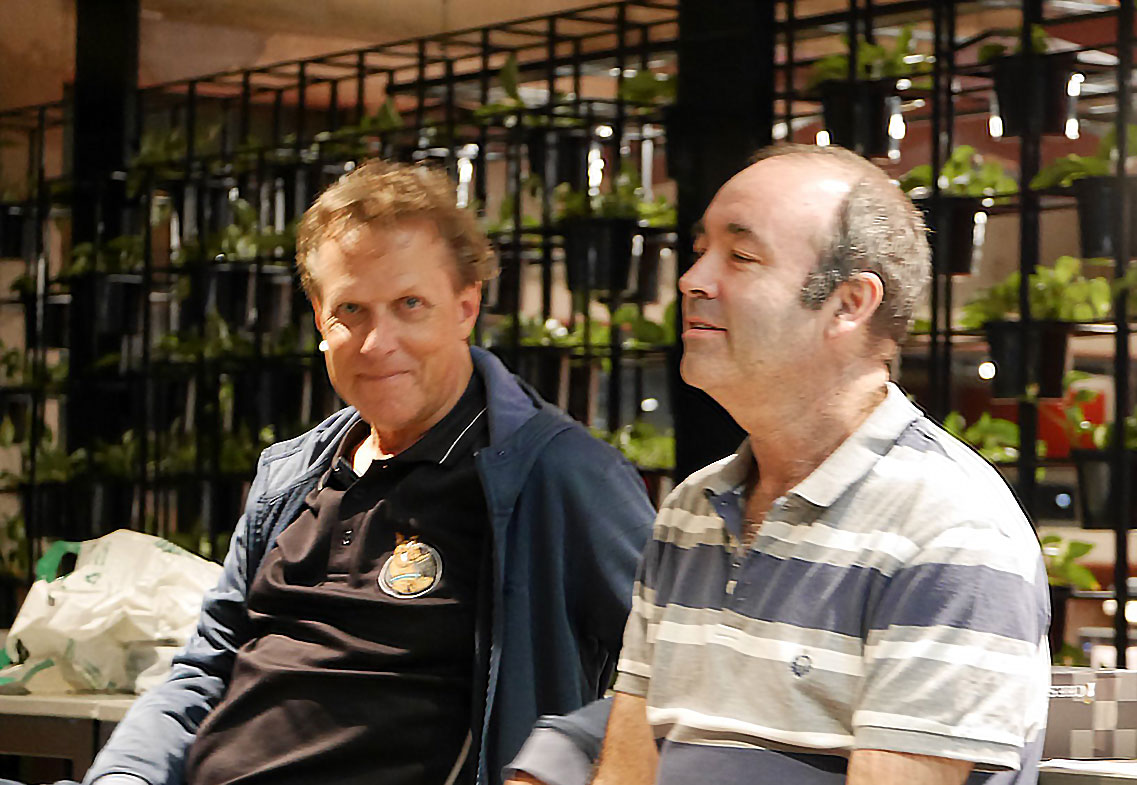
Veteran organiser Shaun Press (R) with IM Gary Lane | Photo: Helen Milligan
This itself was the first sign that déjà vu was about to hit big time: I first played Gary in the old tournament and had barely seen him since. Checking an early version of the starting list, I saw this familiar name crop up:
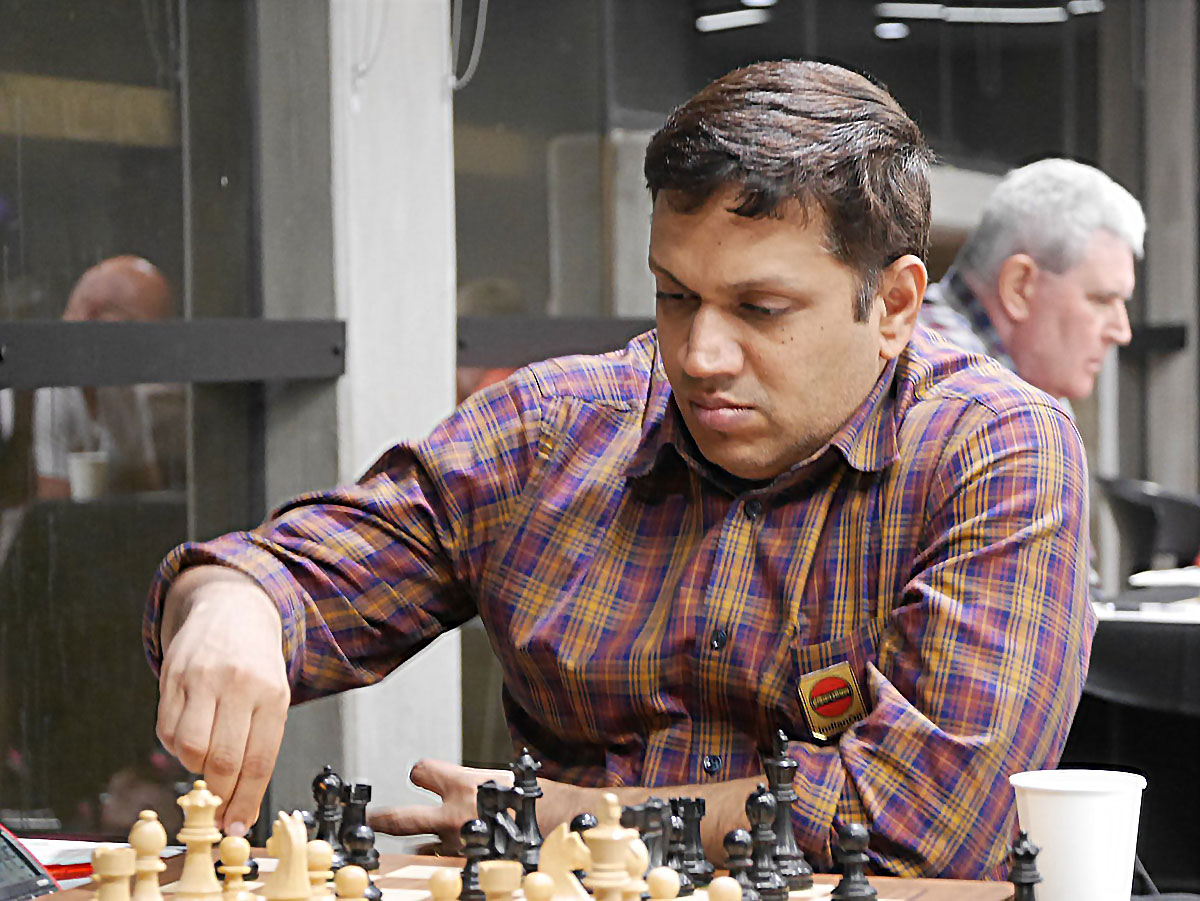
GM Abhijit Kunte | Photo: Helen Milligan
The last time I'd played a competitive game in Sydney had been against him, a full nine years ago; the result was a study-like endgame swindle that attracted a little notoriety at the time. Oddly, this year too I was to have a lucky endgame escape and finish on 6½/9...
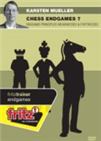 The 7th volume of this endgame series deals with many different aspects of endgame play: the art of pawn play, weaknesses, converting an advantage, stalemate, fortresses, the art of defence and typical mistakes. Learn how to convert an extra piece or an exchange or how to exploit space advantage and better mobility. The themes the art or defence, fortress and stalemate are also intertwined. If your position has a solid fundament then you may surprisingly reach a fortress which might even be based on a stalemate.
The 7th volume of this endgame series deals with many different aspects of endgame play: the art of pawn play, weaknesses, converting an advantage, stalemate, fortresses, the art of defence and typical mistakes. Learn how to convert an extra piece or an exchange or how to exploit space advantage and better mobility. The themes the art or defence, fortress and stalemate are also intertwined. If your position has a solid fundament then you may surprisingly reach a fortress which might even be based on a stalemate.Later I noticed more names that I had barely seen (if at all) since the 2010 event: GM-elect George Xie and FM Raymond Song. Truly, the pieces were coming together. The latter proceeded to win the event and will be the subject of a later interview in these pages; his comeback to chess is something of a sensation in Asia-Pacific circles at the moment because he's just made 2 IM norms and his next rating will be around 2450!
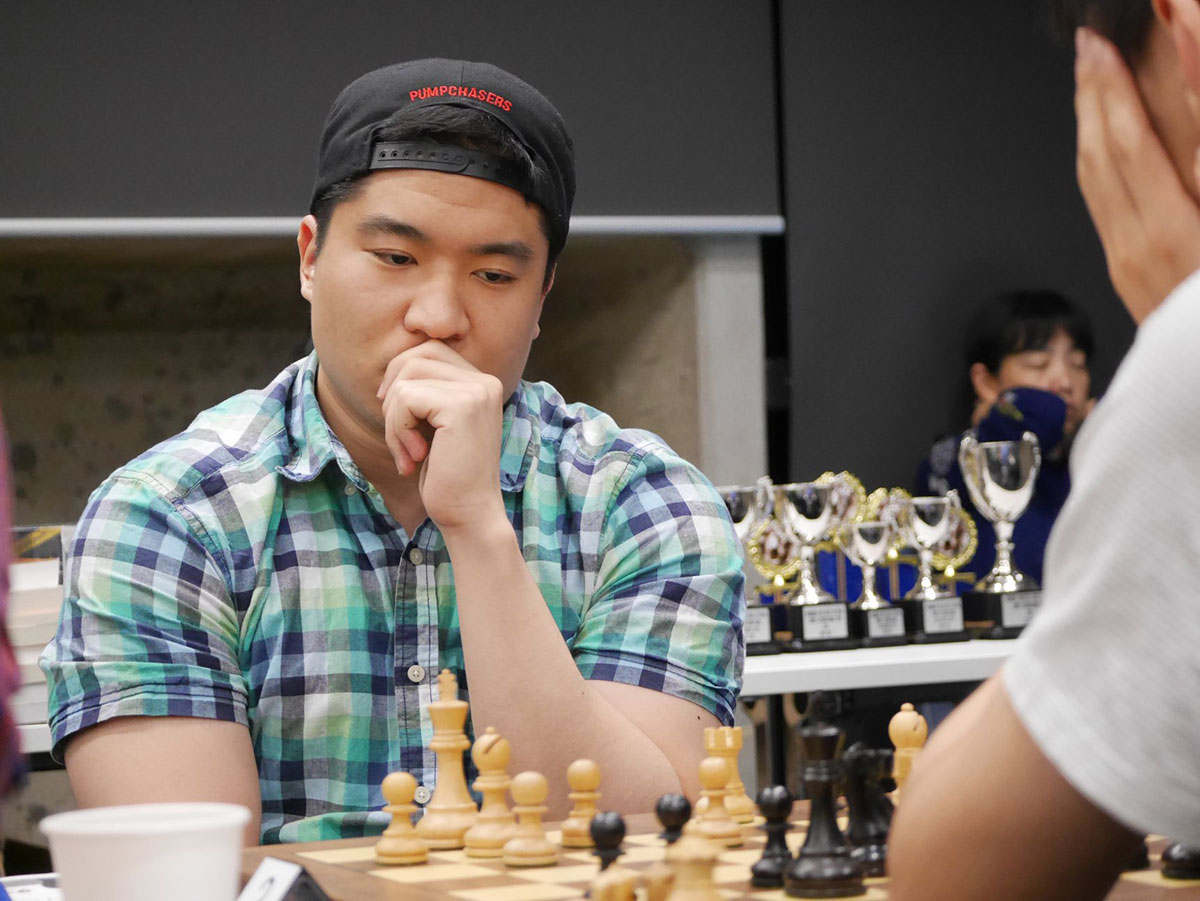
FM Raymond Song | Photo: Helen Milligan
Fast-forwarding to the actual week of the event, it seemed I wouldn't have such a rosy experience this time: I'd be going straight to the first round from the airport, having just travelled back from Malaysia, and the public transport links from my student accommodation in Sydney to the venue weren't particularly easy. Additionally, I had the makings of a moderate-to-severe cold.
So it wasn't a bad thing that my first round was a win by default. Later, though, this was to complicate matters: it turned out my opponent had actually requested a bye which had simply not been processed, so he had to receive a half point and the game couldn't be counted as a win for me for tie-break purposes, even though it did in the cross-table.
After that I noticed my first serious problem with the tournament: the gap between games was too short to do anything with (like watch a movie in the nearby mall, or go home) but too long to do nothing with! The tournament was played to an odd schedule with double-rounds each day at 12 noon and 6pm, and with a time-control of "90/30" it was pretty clear that almost every game would be over within 4 hours. My own preference would be to have the rounds at 9:30am and then 2:30 or 3pm, but this being the first iteration of the event, everyone will doubtless have their feedback to give, and the organiser Paul Russell has already been quite responsive to mine.
As with all double-round tournaments, things proceeded apace. There was barely time to breathe, let alone prepare, and certainly not to take stock. But by the second day it was already clear to most observers that Song, who made his first IM-norm just the previous week, was still on good form, beating his future co-winner in an opening where it seemed White was lacking fresh ideas (so much so that a recent game between top players included the baffling retreat 13.♗c1!?)
On this DVD Grandmaster Daniel King offers you a repertoire for Black against the Catalan, based around maintaining the rock of a pawn on d5. Keeping central control ultimately gives Black good chances to launch an attack against the enemy king.
It seemed at that stage like the only player who could match him was the top seed GM Abhijit Kunte, and the two were due to face off in the 5th round. In spite of (or because of) the result, it seems that Raymond was the more energised afterwards, while Kunte sank back when at 4½/5 and began making draws (starting with one against yours truly), with only one of those draws being double-edged.
The Nimzo-Indian, the Gruenfeld and the King's Indian Defence are three incredibly uncomfortable defences to meet. This hypermodern DVD gives new ideas on how to squash these setups with sound, positional play based on double fianchetto systems.
The last-mentioned game (round 6) between the two top seeds was so dull that my opponent took barely half an hour to play it, while I amused myself with seeing which arbiters and organisers (other than those already mentioned) I could recognise! First mention should go to the photographer who took all these images — Kiwi WFM Helen Milligan, who I believe once arbitrated a match of mine in the 2010 Olympiad; there were some other familiar faces as well as some new ones in roughly even measure, as you'll see a bit later.
Top results and standings after Round 6
| 1 |
11 |
FM |
Song Raymond |
TPE |
2329 |
2420 |
5,0 |
0,0 |
5 |
22,5 |
| 2 |
9 |
IM |
Lane Gary W |
AUS |
2357 |
2481 |
5,0 |
0,0 |
5 |
21,5 |
| 3 |
1 |
GM |
Kunte Abhijit |
IND |
2485 |
2506 |
5,0 |
0,0 |
4 |
23,5 |
| 4 |
3 |
IM |
Ikeda Junta |
AUS |
2441 |
2551 |
5,0 |
0,0 |
4 |
21,0 |
| 5 |
6 |
IM |
Padmini Rout |
IND |
2364 |
2332 |
4,5 |
0,0 |
4 |
24,5 |
| 6 |
2 |
GM |
Fernandez Daniel Howard |
ENG |
2467 |
2349 |
4,5 |
0,0 |
2 |
21,5 |
| 7 |
7 |
IM |
McClymont Brodie |
AUS |
2360 |
2374 |
4,0 |
0,0 |
3 |
23,5 |
| 8 |
16 |
FM |
Gong Daniel Hanwen |
NZL |
2246 |
0 |
4,0 |
0,0 |
3 |
20,5 |
| 9 |
10 |
IM |
Solomon Stephen J |
AUS |
2338 |
2383 |
4,0 |
0,0 |
3 |
20,5 |
| 10 |
13 |
FM |
Puccini Jack |
AUS |
2261 |
2331 |
4,0 |
0,0 |
3 |
20,0 |
The Home Stretch: Rounds 7-9
With three rounds to play, there was a large group of players in contention for the top prizes, and at this point the games became interesting to me from an opening point of view as well as a practical one!

Yours truly, the day before a major shave | Photo: Helen Milligan
In round 7 I almost got the chance to test one of the critical but unplayed lines from my DVD over the board. As it is I was able to demonstrate safe equality for Black in another line. After missing the tactic in the late middlegame and being told about it afterwards, I became quite demoralised for the following games and was quite lucky to not lose either, while my opponent seemed to gain strength from it and won rounds 8 and 9...
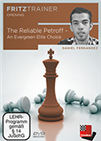 The Petroff (or Russian) Defence which is characterised by the moves 1.e4 e5 2.Nf3 Nf6 has been popular at the highest levels for many years and enjoys the reputation of being an extremely solid defence.
The Petroff (or Russian) Defence which is characterised by the moves 1.e4 e5 2.Nf3 Nf6 has been popular at the highest levels for many years and enjoys the reputation of being an extremely solid defence.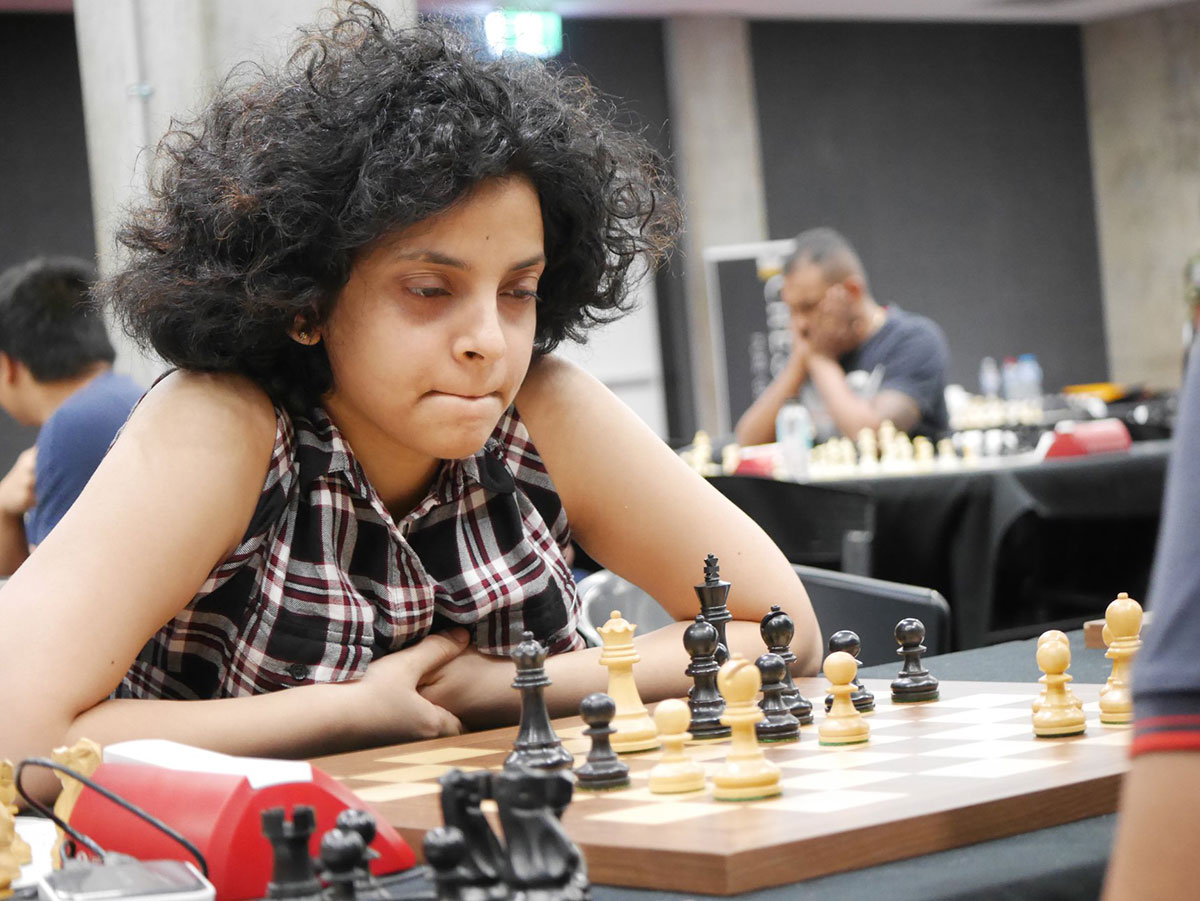
IM Padmini Rout | Photo: Helen Milligan
In round 8 my good friend and ambitious Australian IM Junta Ikeda very much had the top seed on the ropes, having taken a quick draw in round 7 so as to be well rested. Under normal circumstances I expect he would have won, but with the game stretching well past 10pm and both clocks running quite low, eventually he let the grandmaster wriggle loose. As luck would have it, he then probably went slightly 'on tilt' just at the moment when Padmini (see above) was picking up some momentum, and was paired against her in the final round.
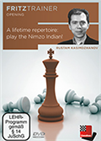 This DVD provides everything you need to know to be able to play one of the most classical openings with Black, the Nimzo-Indian, arising after 1.d4 Nf6 2.c4 e6 3.Nc3 Bb4. Nearly every World Championship and top tournament features the Nimzo-Indian.
This DVD provides everything you need to know to be able to play one of the most classical openings with Black, the Nimzo-Indian, arising after 1.d4 Nf6 2.c4 e6 3.Nc3 Bb4. Nearly every World Championship and top tournament features the Nimzo-Indian.
IM Junta Ikeda | Photo: Helen Milligan
Finally, round 9 saw the opening testing-ground of my dreams: on the top 2 boards, both Black players badly needed to win, and both chose the Modern! I'm currently writing a book on the opening and am trying to test a range of lines within it when I have a chance. As you might have deduced, though, things didn't go exactly to plan:
The upshot of those two results was that Padmini and Song jointly won the tournament on 7/9, with the latter gaining the shinier trophy due to direct encounter being the tiebreak. However, the top prizes of AUD $3,000 (about USD $2,100) and $1,500 were both split two ways. (Anyone else think that's generous? There must surely be more GM entries next year!) Meanwhile, the two top seeds had to be content sharing 3rd place, a half point behind:

(L to R) Organiser Paul Russell, FM Raymond Song, IM Padmini Rout | Photo: Helen Milligan

(L to R) Russell with GM Abhijit Kunte, GM Daniel Fernandez | Photo: Helen Milligan
Possibly, in the above you may have got the idea that the tournament was more or less a one-man show. This would not be accurate, and there were an army of people working hard to make it possible — including a remarkable number of new faces.
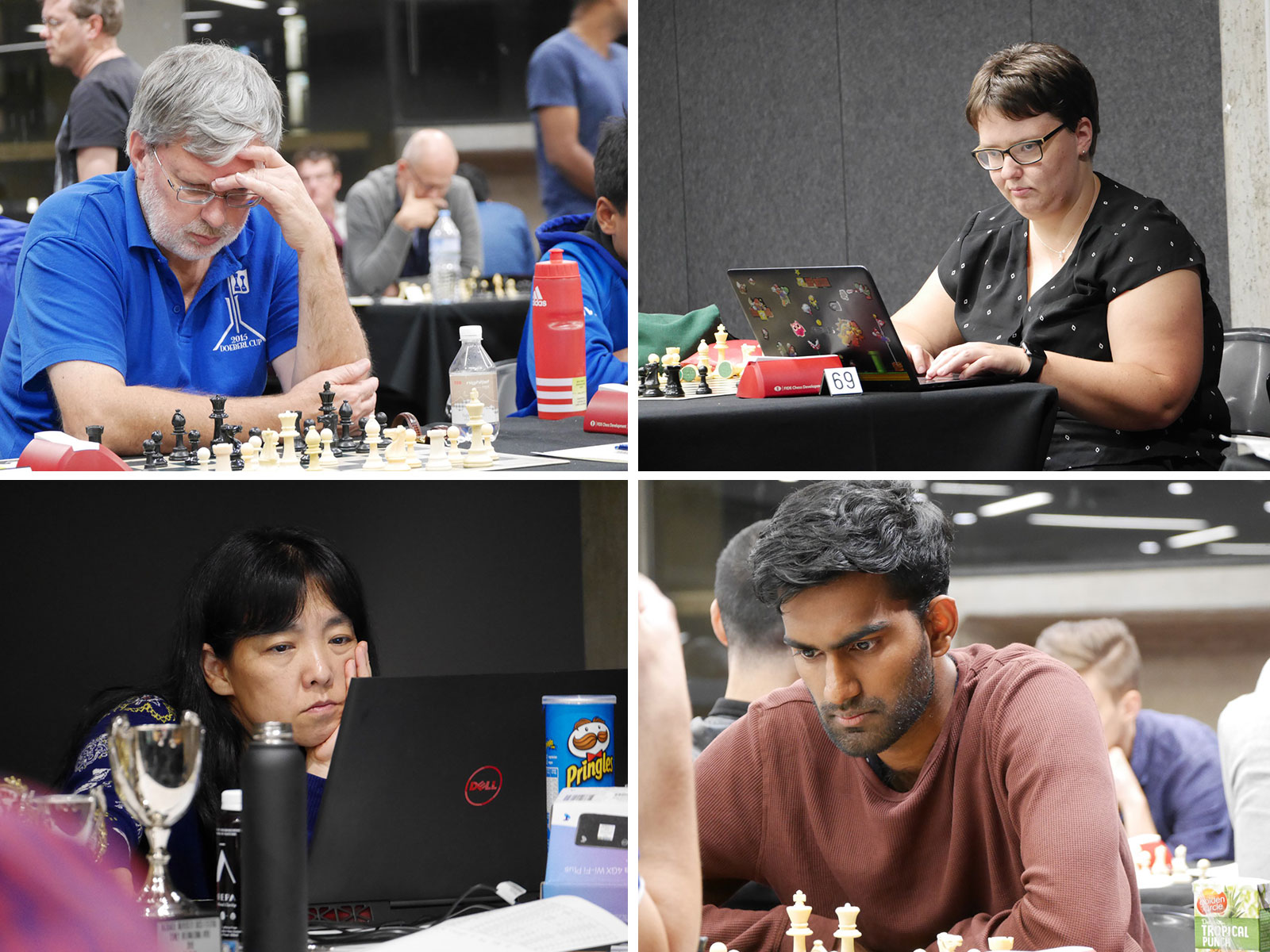
Clockwise from left: Experienced New Zealand organiser Hilton Bennett was playing as well as helping out; Chief arbiter Alana Chibnall; Newly trained New Zealand arbiter was managing the live board transmission; Pasan Perera was a big help in liaising with the university chess scene in Sydney — including myself! | Photos: Helen Milligan
Obviously, with any new event there are going to be some things that don't go smoothly — aside from the odd round times there were one or two issues with lighting. Equally, obviously, I didn't play as well as I hoped, but since I'm now 24 years old and not 15 like before, it's a lot easier for me to distinguish feelings about the tournament as a whole from the emotional roller-coaster of individual wins and losses! I very much hope this event continues and that it will attract an even stronger field in years to come, regaining or surpassing its former glory.
Final standings (Open — top 20)
| 1 |
11 |
FM |
Song Raymond |
TPE |
2329 |
2420 |
7,0 |
1,0 |
6 |
50,5 |
| 2 |
6 |
IM |
Padmini Rout |
IND |
2364 |
2332 |
7,0 |
0,0 |
6 |
51,5 |
| 3 |
1 |
GM |
Kunte Abhijit |
IND |
2485 |
2506 |
6,5 |
0,5 |
4 |
50,5 |
| 4 |
2 |
GM |
Fernandez Daniel Howard |
ENG |
2467 |
2349 |
6,5 |
0,5 |
3 |
52,0 |
| 5 |
9 |
IM |
Lane Gary W |
AUS |
2357 |
2481 |
6,0 |
0,0 |
5 |
54,0 |
| 6 |
8 |
IM |
Xie George Wendi |
AUS |
2359 |
2375 |
6,0 |
0,0 |
5 |
46,0 |
| 7 |
17 |
WGM |
Zhang Jilin |
AUS |
2243 |
2222 |
6,0 |
0,0 |
5 |
45,0 |
| 8 |
3 |
IM |
Ikeda Junta |
AUS |
2441 |
2551 |
6,0 |
0,0 |
4 |
51,5 |
| 9 |
7 |
IM |
McClymont Brodie |
AUS |
2360 |
2374 |
6,0 |
0,0 |
4 |
49,0 |
| 10 |
5 |
GM |
Johansen Darryl K |
AUS |
2364 |
2447 |
6,0 |
0,0 |
4 |
45,5 |
| 11 |
10 |
IM |
Solomon Stephen J |
AUS |
2338 |
2383 |
6,0 |
0,0 |
4 |
44,5 |
| 12 |
22 |
FM |
Hu Jason |
AUS |
2132 |
2263 |
5,5 |
0,0 |
5 |
44,0 |
| 13 |
21 |
FM |
O`Chee Kevin |
AUS |
2146 |
2251 |
5,5 |
0,0 |
5 |
42,0 |
| 14 |
15 |
|
Largo Bengt |
PHI |
2257 |
2257 |
5,5 |
0,0 |
5 |
39,0 |
| 15 |
30 |
|
Rodgers Jack |
AUS |
2014 |
2119 |
5,5 |
0,0 |
5 |
35,5 |
| 16 |
16 |
FM |
Gong Daniel Hanwen |
NZL |
2246 |
0 |
5,5 |
0,0 |
4 |
46,0 |
| 17 |
13 |
FM |
Puccini Jack |
AUS |
2261 |
2331 |
5,5 |
0,0 |
4 |
43,5 |
| 18 |
32 |
FM |
Hamal Manish |
NEP |
2008 |
0 |
5,0 |
0,0 |
4 |
48,5 |
| 19 |
4 |
IM |
Dale Ari |
AUS |
2372 |
2440 |
5,0 |
0,0 |
4 |
45,5 |
| 20 |
19 |
|
Winkelman Albert |
AUS |
2212 |
2252 |
5,0 |
0,0 |
4 |
44,0 |
Final standings (Challengers — top 10)
| 1 |
46 |
|
Keating Jack |
AUS |
1484 |
1376 |
8,0 |
0,0 |
7 |
52,0 |
| 2 |
2 |
CM |
Chek Adrian Carl |
AUS |
1932 |
1907 |
7,0 |
0,0 |
5 |
50,5 |
| 3 |
1 |
|
Iandolo Marco |
ITA |
1936 |
1880 |
6,5 |
0,0 |
6 |
50,0 |
| 4 |
35 |
|
Vincent Alaina |
IND |
1557 |
1524 |
6,5 |
0,0 |
6 |
46,5 |
| 5 |
19 |
|
Lee Lachlan |
AUS |
1695 |
1540 |
6,5 |
0,0 |
6 |
44,5 |
| 6 |
4 |
|
Lane Ryan |
AUS |
1907 |
1814 |
6,5 |
0,0 |
5 |
53,5 |
| 7 |
73 |
|
Sandoval Anthony |
AUS |
0 |
0 |
6,0 |
0,0 |
6 |
45,5 |
| 8 |
14 |
|
Tulevski Vasil G |
AUS |
1782 |
1748 |
6,0 |
0,0 |
6 |
35,5 |
| 9 |
25 |
|
Kumar Viney |
AUS |
1645 |
1527 |
6,0 |
0,0 |
5 |
49,0 |
| 10 |
34 |
|
Wang Aaron Ziwen |
NZL |
1582 |
0 |
6,0 |
0,0 |
5 |
45,5 |
All available games
Links






































